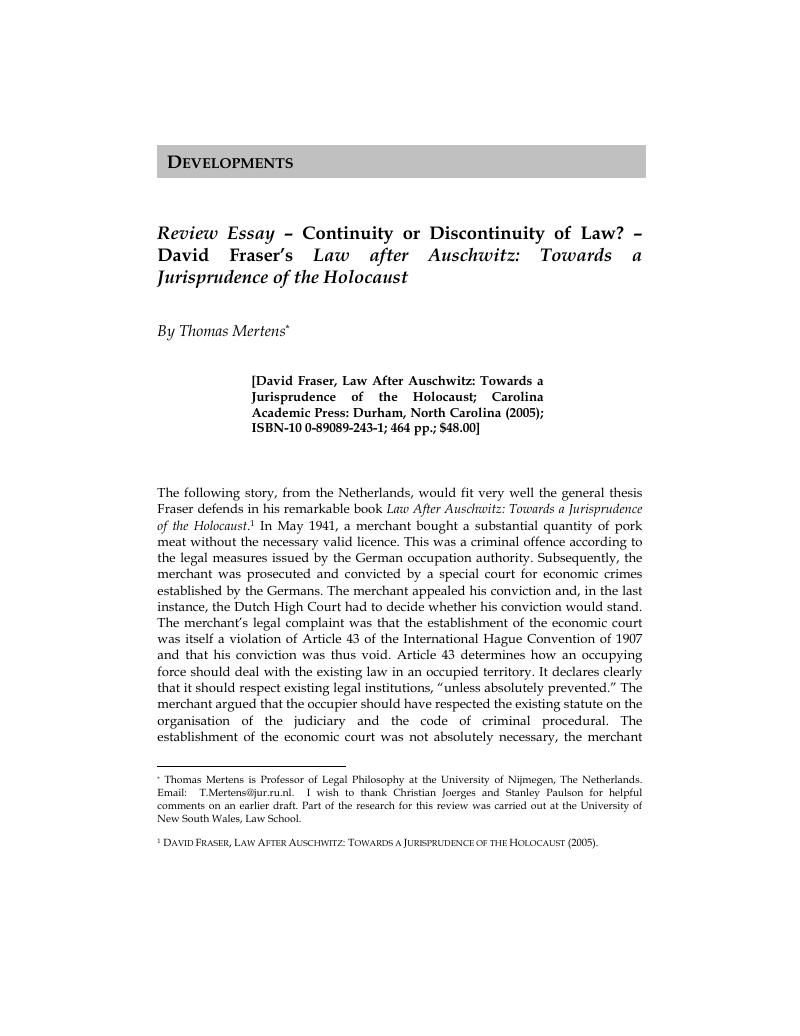Published online by Cambridge University Press: 06 March 2019

1 David Fraser, Law After Auschwitz: Towards a Jurisprudence of the Holocaust (2005).Google Scholar
2 Het ‘toetsingsarrest’, Hoge Raad [HR] [Supreme Court of the Netherlands], 1 December 1942, NJ 1942, 271.Google Scholar
3 See J. Michielsen, The “Nazification” and “Denazification” of the Courts in Belgium, Luxemburg and The Netherlands Chapter 4 (2004); D. Venema, Rechters in oorlogstijd: De confrontatie van de Nederlandse rechterlijke macht met nationaal-socialisme en bezetting Chapter 3 (2007) (for an overview).Google Scholar
4 G. Radbruch, Gesetzliches Unrecht und übergesetzliches Recht, originally in: Süddeutsche Juristenzeitung 105-108 (1946); reprinted in G. Radbruch, Der Mensch im Recht 111-124 (1957); and G. Radbruch, Rechtsphilosophie 347-357 (E. Wolf ed., 7th ed., 1970); and G. Radbruch, Gesamtausgabe 83-93 (A. Kaufmann ed., 1990). There is a new German edition of the Rechtsphilosophie with editorial footnotes, edited by Stanley L. Paulson and Ralf Dreier, which includes this famous essay: G. Radbruch, Rechtsphilosophie (Studienausgabe) 211-219 (1999). Recently a new translation of this famous text appeared as G. Radbruch, Statutory Lawlessness and Supra-Statutory Law (Bonnie Litschewski Paulson and Stanley L. Paulson trans.), in 26 Oxford Journal of Legal Studies 1-11 (2006).Google Scholar
5 See R. Alexy, The Argument from Injustice: A Reply to Legal Positivism (Bonnie Litschewski Paulson and Stanley L. Paulson trans., 2002) for a contemporary defense of Radbruch's approach.Google Scholar
6 Fraser, supra note 1, at 44, 21.Google Scholar
7 Fraser seems to use the concepts of Holocaust, Auschwitz and Shoah as interchangeable.Google Scholar
8 See Fraser, supra note 1, at 5, 13, 15 for the proposition that Auschwitz was lawful.Google Scholar
9 Id. at 48.Google Scholar
10 Fraser has also published on the occupation of the Channel Islands and on Belgium. See David Fraser, The Jews of the Channel Islands and the Rule of Law: 1940-1945 (2000); Fraser, David, The Fragility of Law: Anti-Jewish Decrees, Constitutional Patriotism and Collaboration in Belgium 1940-1944, 14 Law and Critique 253-275 (2003).Google Scholar
11 Perhaps, Fraser takes the relevance of this point too seriously; the outsider's perspective is necessarily a sociological or positivist point of view. See e.g. Alexy, , supra note 5.Google Scholar
12 Fraser, , supra note 1, at 79.Google Scholar
13 Id. at 95.Google Scholar
14 Id. at 425.Google Scholar
15 Remarkably, Fraser does not discuss the Eichmann trial in Jerusalem, in which–contrary to the Nuremberg trials (in which, as he writes, the Holocaust only played a “secondary role”)–this was absolutely central. See id. at 130.Google Scholar
16 Id. at 251.Google Scholar
17 Id. at 254, 341, 418.Google Scholar
18 Id. at 293.Google Scholar
19 Id. at 213.Google Scholar
20 Id. at 28.Google Scholar
21 Id. at 7.Google Scholar
22 Id. at 12.Google Scholar
23 Id. at 142.Google Scholar
24 Id. at 77.Google Scholar
25 Id. at 145.Google Scholar
26 Mertens, Thomas, Radbruch and Hart on the Grudge Informer: A Reconsideration, 15 Ratio Juris 186-205 (2002).CrossRefGoogle Scholar
27 Fraser, supra note 1, at 23.Google Scholar
28 See id. at 235; or, in relation to Canada at 349: “… he was forced to leave Canada not because he killed Jews but because he lied about killing Jews.”Google Scholar
29 See, e.g., I. Müller, Furchtbare Juristen, Die unbewältigte Vergangenheit unserer Justiz (1989).Google Scholar
30 Fraser, supra note 1, at 27.Google Scholar
31 Id. at 16.Google Scholar
32 Id. at 55.Google Scholar
33 Id. at 36.Google Scholar
34 This was possible because of the notorious “Gesetz zur Wiederherstellung des Berufsbeamtentums” of April 7, 1933.Google Scholar
35 Zimmerman, R., Was Heimat hiess, nun heisst es Hoelle, in Jurists Uprooted. German Speaking Émigré Lawyers in Twentieth-century Britain 1-71 (J. Beatson, R. Zimmerman eds., 2004).CrossRefGoogle Scholar
36 Fraser, supra note 1, at 144.Google Scholar
37 Id. at 24.Google Scholar
38 This was the perspective chosen, for example, by C. Schmitt, in: Staat, Bewegung, Volk 7 (1933); if on the other hand, the Enabling Act derived its legitimacy from the Weimar Constitution, as Fraser seems to say, then the constraints of that constitution should have remained valid too. But as is well known, the civil rights which could not be restricted under Article 48 were as easily put aside as other constitutional devises of “Weimar”. So the continuity thesis is doubtful here either way.Google Scholar
39 Pogány, I., 6 Human Rights Law Review 428 (2006) (reviewing David Fraser, Law after Auschwitz (2005); See also R.O. Paxton, The Anatomy of Fascism 163 (2004), “…. outside the reach of the German normative state and of German law.”Google Scholar
40 See, e.g., R.O. Paxton, The Anatomy of Fascism 119 (2004) (for an overview). Paxton distinguishes between the normative and the prerogative state. See also Mueller, supra note 29, at 294.Google Scholar
41 H. Weinkauff, Die Deutsche Justiz und der Nationalsozialismus: Ein Ueberblick 46-56 (1968).Google Scholar
42 Fraser, supra note 1, at 319.Google Scholar
43 Id. at 8.Google Scholar
44 Id. at 28, 21.Google Scholar
45 Id. at 77, 212.Google Scholar
46 See, e.g., id at 13, 15, 55.Google Scholar
47 Id. at 8.Google Scholar
48 Id. at 10.Google Scholar
49 Id. at 12-13.Google Scholar
50 Id. at 145, 213.Google Scholar
51 Id. at 198, 277, 298.Google Scholar
52 Id. at 324.Google Scholar
53 Id. at 21.Google Scholar
54 Stolleis, M., Prologue: Reluctance to Glance in the Mirror: The Changing Face of German Jurisprudence after 1933 and post-1945, in Darker Legacies of Law in Europe 1-18 (C. Joerges, N.S. Galeigh eds., 2003).Google Scholar
55 Hof Leeuwarden 25 February 1943, NJ 1951, 643.Google Scholar
56 Curran, V. Grosswald, Formalism and Anti-Formalism in French and German Judicial Methodology, in Darker Legacies of Law in Europe 207, 225 (C. Joerges, N.S. Galeigh eds., 2003).Google Scholar